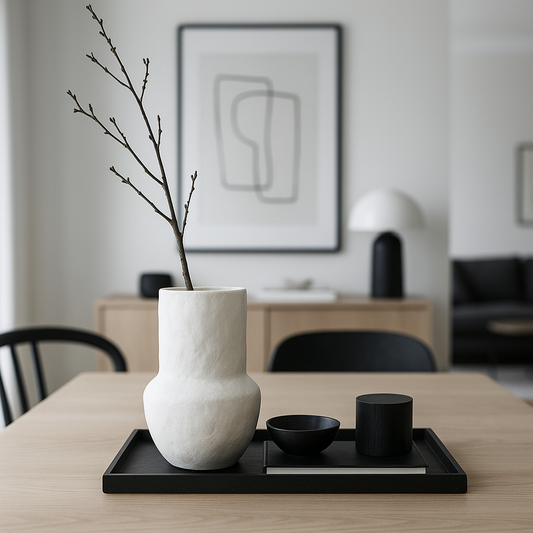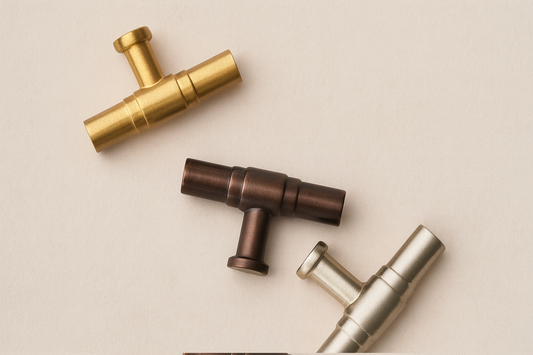How to Mix Metal Finishes Like a Designer (And Avoid Matchy-Matchy Mistakes)
One of the most common questions I get asked as an interior designer is:
"If I choose gold tapware, do I have to use gold accents throughout the whole house to make it match?"
My answer? You don’t need to. And honestly—you shouldn’t.
Using the same metal finishes throughout your home is often the default because it’s familiar and safe. But great design isn’t about playing it safe—it’s about contrast, character, and knowing how to break the rules (with intention).
It’s the line between safe and seriously stunning.
From mass-produced vibes to designer-level energy—it’s all in the mix.
When done right, a blend of metal finishes brings sophistication, soul, and that layered, editorial look clients are constantly asking me for.
Whether you're renovating, building, or just switching out your lighting, here's your no-fluff guide to mixing metal finishes—like a designer would.
First, Let’s Talk About the Matchy-Matchy Mistake
If you're matching all of your metal finishes throughout the home—sorry to break it to you—but it's giving builder basic.
Yes, we said it. 😬
When every metal throughout your home is the exact same finish —tapware, door handles, light fittings, even curtain rods—it can make even the most expensive renovation feel a little… flat. You might have invested in beautiful stone and joinery, but the space still feels... unfinished.
Design truth: Uniform finishes are easier—but that doesn’t mean they’re better.
The Art of Mixing Metals (Without the Chaos)
When done right, combining different metal finishes brings depth, personality, and a designer-level balance to your home.
But get it wrong? It can quickly feel chaotic, clashing, or like an accidental mess.
Let’s avoid that and start with these three foolproof principles.
1. Start with a Dominant Metal Finish
Choose one metal to act as your foundation. This is your dominant finish and should be used across primary fittings like:
- Tapware
- Bathroom Accessories like towel hooks
- Appliances (if visible)
- Major hardware (hinges, door handles)
- Cabinet handles
Then, layer in an accent metal. This should show up in smaller, visual elements:
- Lighting
- Mirrors
- Curtain hardware
- Decor and Styling
- Cabinet handles
Think of it like getting dressed: Your dominant metal is the outfit, and your accent metal is the jewellery. It should complement—not compete.
A Balanced Example:
- Dominant: Brushed nickel (tapware, bathroom accessories, handles)
- Accent: Matte black (lighting, mirror frames, decor elements)
Want a shortcut? Use lighting to introduce your accent metal. It instantly shifts the tone of the room and ties finishes together with minimal effort.
2. Match Undertones for a Cohesive Look
All metals finishes have an undertone—warm, cool, or neutral.
Warm Undertones
Metals with warm undertones bring richness, warmth, and a touch of earthiness to a space. Think copper, brass, gold, bronze—even brushed nickel can lean warm in the right light.
Cool Undertones
Metals with cool undertones have that sleek, refined energy—usually showing hints of grey or blue. They bring a crispness to a space that feels polished, modern, and effortlessly sophisticated.
Stainless steel, chrome, and gunmetal are classic examples. Chrome leans a little bluish, while stainless and gunmetal tend to sit in that soft grey zone—perfect for achieving a serene, contemporary look without feeling cold. Brushed Nickel can also fall under cool, depending on the brand.
Neutral Metals
Neutral-toned metals are the quiet achievers of the design world—versatile, balanced, and endlessly adaptable. Matte black is the most recognisable here, effortlessly straddling both warm and cool schemes without clashing. White-plated finishes also fall into this category, offering a soft, modern edge that complements without overpowering.
Brushed nickel and stainless steel are often classed as either warm or cool, but in reality, they can behave more like neutrals—blending beautifully with a mix of tones and materials.
- Warm: Brass, gold, copper
- Cool: Chrome, brushed nickel, gunmetal
- Neutral: Matte black, bronze, white
To avoid clashing, a general rule of thumb is to choose finishes that share a similar temperature undertone—or use one finish sparingly to contrast with intention. Ideally, stick to two different metal finishes, but never more than three.
Easy Metal Finish Pairings:

Pro tip: Always test finishes in person and in natural light. What looks close enough online might be jarringly off when viewed in your actual space.
If you're ever unsure, choose one warm and one neutral. Black, especially, is a great bridge metal that works with nearly everything.
3. Repeat Each Metal for Intentional Design and Styling
One of the biggest mistakes I see? People mix finishes once—then never again. That makes it feel like an accident, not a design decision.
The fix is simple: If you’re introducing a secondary metal, repeat it somewhere else at least twice in a room.
This could look like:
- Matte black lighting + black mirror frame with brushed nickel tapware and cabinet pulls
- Brushed brass sconces + cabinet pull with black tapware & window frames
- Aged bronze tapware + matching towel ring and tray with bronzed-black cabinet pulls + mirror frame
This repetition creates visual rhythm and is key to making your styling feel intentional, not random.
Bonus Tip: Let Lighting & Mirrors Do the Heavy Lifting
If you’re introducing a second finish and don’t know where to begin, start with lighting or mirrors. A pendant, wall sconce, or framed mirror in your accent metal helps define the palette, anchor the room, and draw the eye.
Pair your accent finish with complementary handles, curtain rods, or a matching decor object. Just two or three well-placed pieces are all you need to make the mix feel intentional and polished.
Final Thoughts: Layered, Not Loud
Mixing metals isn't about throwing every finish into the room and hoping for the best. It’s about:
- Choosing a dominant finish
- Mixing with purpose
- Matching undertones (most of the time)
- Repeating strategically
Done right, it brings warmth, contrast, and a deeply curated feel to your home.



Need Help Choosing Your Finishes?
If you're stuck between brushed brass and black or overwhelmed by chrome vs. nickel—I get it. Mixing finishes sounds simple, but it takes vision.
That’s where we come in.
✨ Option 1: Just need some clarity?
Book a 1-hour design session if you’re renovating, refreshing a room, or just want to bounce ideas off someone who gets the whole picture (hi, it’s me). We’ll refine your finishes, talk layout, and give you a confident styling direction—without the overwhelm.
BOOK YOUR 1-HR VIRTUAL DESIGN SESSION
✨ Option 2: Want someone to do it for you?
If you're building or fully renovating and just want the decisions made for you, our New Build/Renovation Colour Selections service is for you. We’ll select the perfect mix of metals, lighting, cabinetry finishes, and more—so you don’t have to second-guess a thing.
BOOK YOUR VIRTUAL COLOUR SELECTION SERVICE
 The Designers Notebook
The Designers Notebook




































